
|
The princely state of Gwalior arose in the early part of the 18th century as one of the constituent states of the Maratha confedaracy. The founder was Ranoji Shinde (later
anglicized to Scindia), a local chieftain who distinguished himself as a soldier and received a grant to serve as the governor in his area. He and his successors expanded the state to
a position of great strength and influence. This was relatively short-lived, however, as by 1802 the British had established control over central India and Gwalior was forced to give up
considerable parts of its territory. Nevertheless, the state still remained relatively large and was one of the only five so-called "21-gun" states at the time of Indian independence.
Gwalior was also one of only 9 Princely States that continued to issue its own coinage right up to the time of independence; most others eventually adopted the coinage ofBritish
India.
|
 |
Mahadji Rao (1761-1794) |
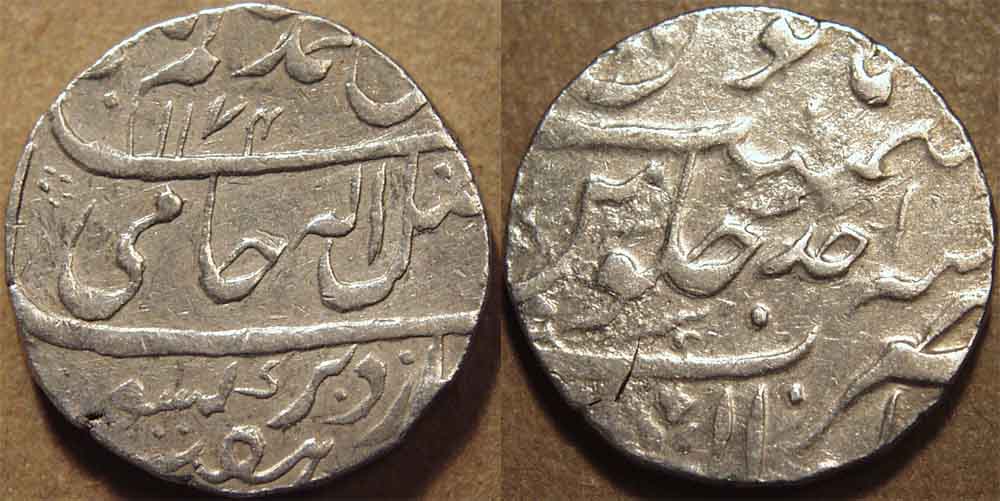
|
Mahadji Rao (1761-1794) Silver rupee in the name of Shah Alam II, year 1, AH 1174
Weight: 11.25 gm. Diameter: 22-23 mm Die axis: 9 o'clock
Legend, naming Shah Alam and the AH date 1174
Legend, including regnal year 1, and mint Gwalior Fort
Reference: KM 55
|
 |
Mahadji Rao was the illegitimate son of Ranoji.
|

|
Mahadji Rao (1761-1794) Silver rupee in the name of Shah Alam II, year 21, AH 1194
Weight: 11.34 gm. Diameter: 22 mm Die axis: 10 o'clock
Legend, naming Shah Alam and the AH date 119x (probably 1194)
Legend, including regnal year 21, mintmark dagger and mint name Ujjain
Reference: KM 218 (C259)
|
 |
A most interesting coin, because it shows the full mintmark, which is hardly ever seen (the next coin is more typical). The mark is normally
described as a scimitar, but here we see that it is almost certainly meant to be a dagger, with a wavy blade like a kris. So this coin suggests that a reassessment is necessary of
what exactly the Ujjain mintmark is.
|
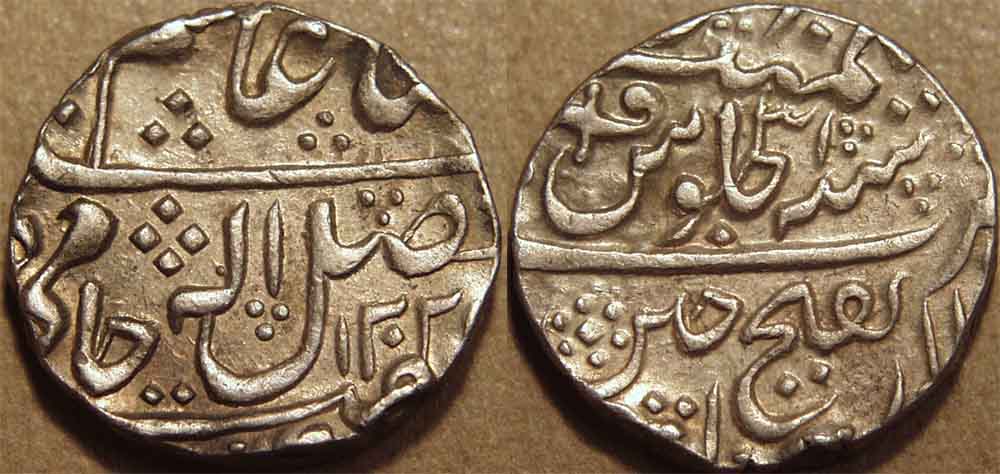
|
Mahadji Rao (1761-1794) Silver rupee in the name of Shah Alam II, year 31, AH 1202
Weight: 11.26 gm. Diameter: 21-22 mm Die axis: 7 o'clock
Legend, naming Shah Alam and the AH date 1202
Legend, including regnal year 31, mintmark dagger and mint name Ujjain
Reference: KM 218 (C259)
|
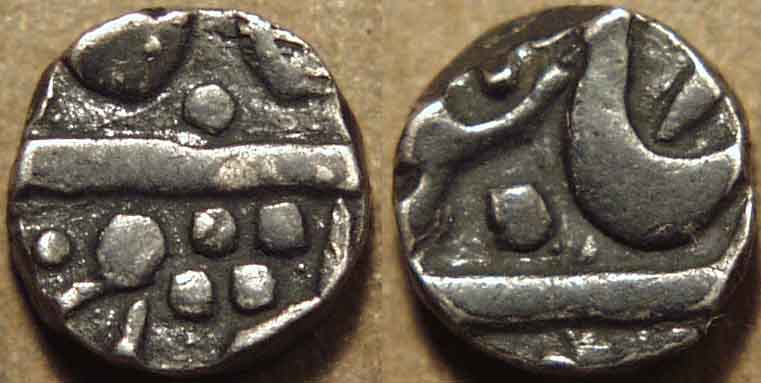
|
Mahadji Rao (1761-1794) Silver 1/8 rupee in the name of Shah Alam II, Ujjain
Weight: 1.41 gm. Diameter: 9 mm Die axis: 12 o'clock
Legend, naming Shah Alam
Legend, including mint name Ujjain
Reference: KM 214
|
 |
Daulat Rao (1794-1827) |
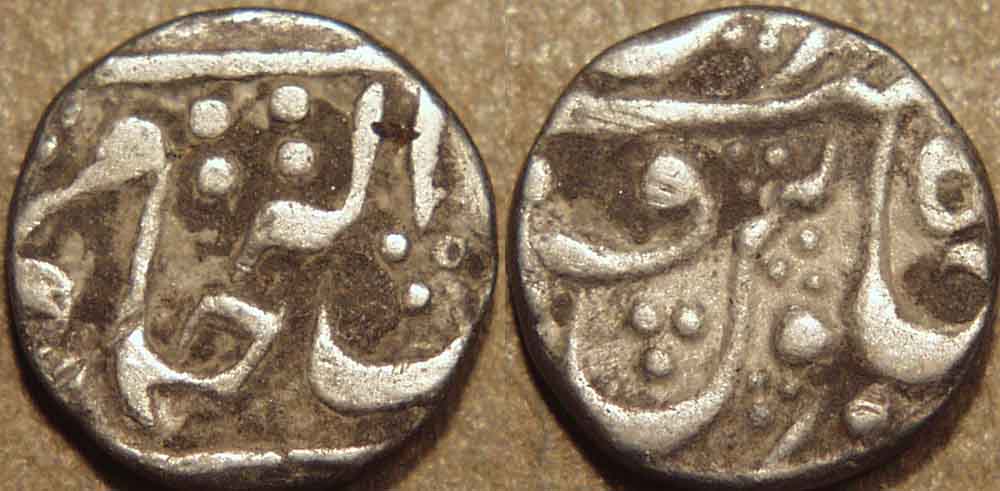
|
Daulat Rao (1794-1827) Silver 1/4 rupee in the name of Shah Alam II, year 5x, Ujjain
Weight: 2.72 gm. Diameter: 13 mm Die axis: 7 o'clock
Legend, including 4-dot cluster of Ujjain
Legend, including regnal year 5x, and handle of curved dagger (Ujjain mintmark)
Reference: A223 (unlisted date)
|
 |
Mahadji did not have a son and was succeeded by the grandson of his brother Tukaji, Daulat Rao.
KM lists only RY dates 62 and 64 for the 1/4 rupee, although several RY dates in the '50s exist for the rupee. Note that, although Shah Alam II had died in 1806, in the 47th year of
his reign, this and all subsequent coins of Gwalior until 1858 continued to be issued in the name of Shah Alam II and listed his regnal year.
|
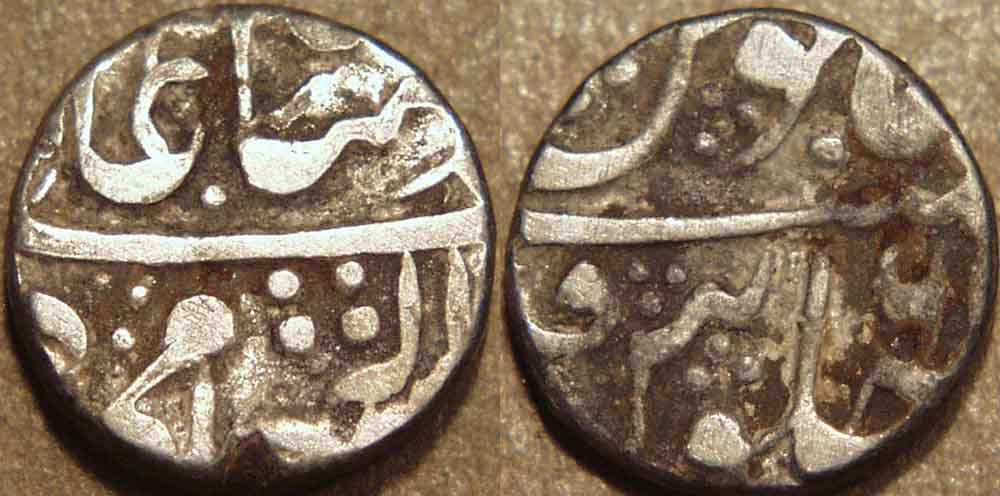
|
Daulat Rao (1794-1827) Silver 1/4 rupee in the name of Shah Alam II, year 6x, Ujjain
Weight: 2.71 gm. Diameter: 12 mm Die axis: 5 o'clock
Legend, including 4-dot cluster of Ujjain
Legend, including regnal year 6x, and handle of curved dagger (Ujjain mintmark)
Reference: A223
|
 |
Baija Bao (1827-1833) |
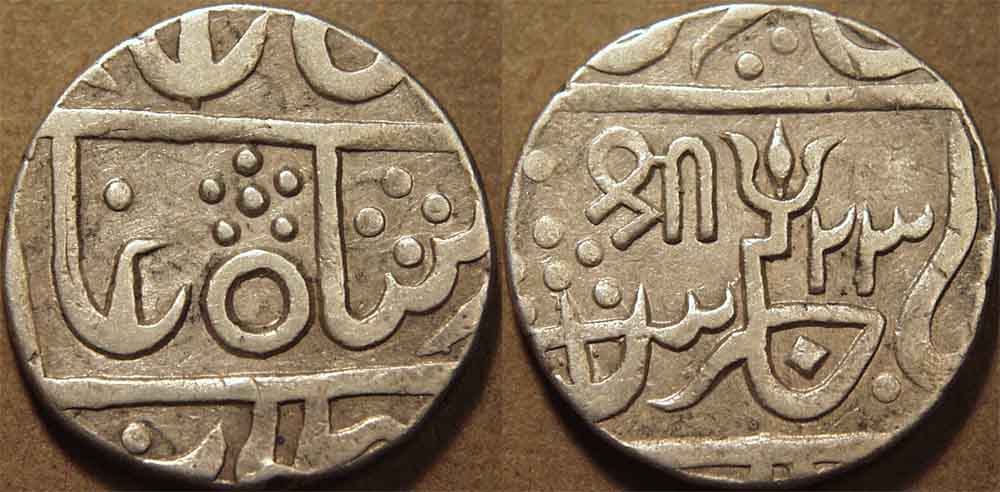
|
Baija Bao (1827-33) Silver rupee in the name of Shah Alam II, year 23, Lashkar
Weight: 10.88 gm. Diameter: 23 mm Die axis: 3 o'clock
Legend, naming Shah Alam
Legend, with sri and trident of Baija Bao, mintname Lashkar off flan
Reference: KM 129
|
 |
Baija Bao was the wife of Daulat Rao. When Daulat Rao died in 1827, he left no son, so Baija Bao adopted a distant scion of the family,
who became Jankoji Rao II. However, at the time of his adoption, Jankoji was only 11 years old, so Baija Bao ruled in his place until he was old enough to take the throne.
It is not clear what the year "23" signifies on this coin. It is obviously not the regnal year of Shah Alam II, nor could it really have stood for year 63 of that king (with the 6 being
retrograde), as that would still have fallen within Daulat Rao's reign. Neither is it year 23 or year 32 of Daulat Rao's reign, as he reigned for 33 years. So the date seems to be a
mystery.
|
 |
 |
 |
Jankoji Rao II (1833-1843) |

|
Jankoji Rao II (1833-43) AR 1/4 rupee in the name of Shah Alam II, Ujjain mint, RY 8x
Weight: 10.88 gm. Diameter: 23 mm Die axis: 3 o'clock
Legend, including 4-dot cluster of Ujjain
Legend, including regnal year 8x
Reference: KM A229
|
 |
Jayaji Rao (1843-1886) |
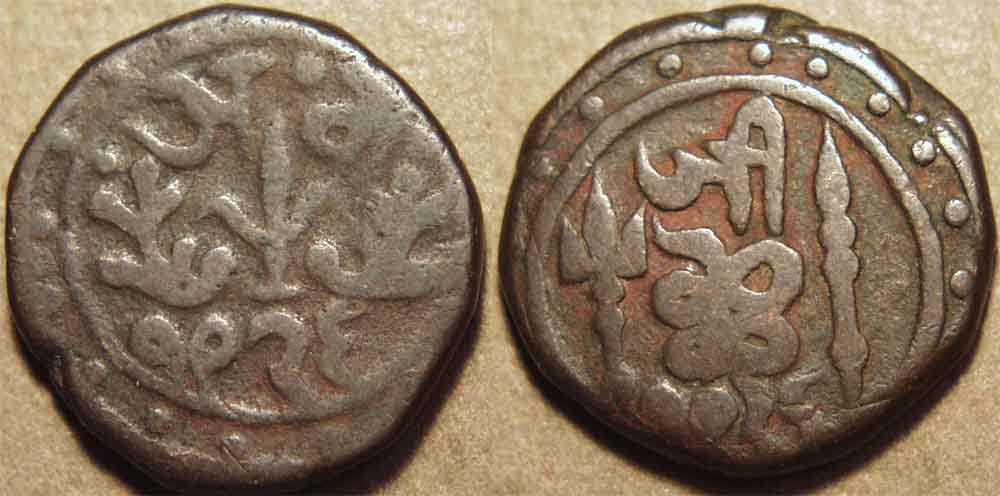
|
Jayaji Rao (1843-1886) AE paisa, VS 1926 (= 1869), Lashkar mint
Weight: 5.70 gm. Diameter: 18-19 mm Die axis: 3 o'clock
Within ruled and dotted circles, trident flanked by leaf sprigs, Nagari a va above, VS date 1926 below
Within ruled and dotted circles, coiled cobra flanked by trident and spear, Nagari ji above, VS date 1926 below
Reference: KM 143 (Y29)
|
 |
After the deposition of the last Mughal emperor, Bahadur Shah Zafar, in 1858, the coinage in the name of the Mughal emperor ceased.
|
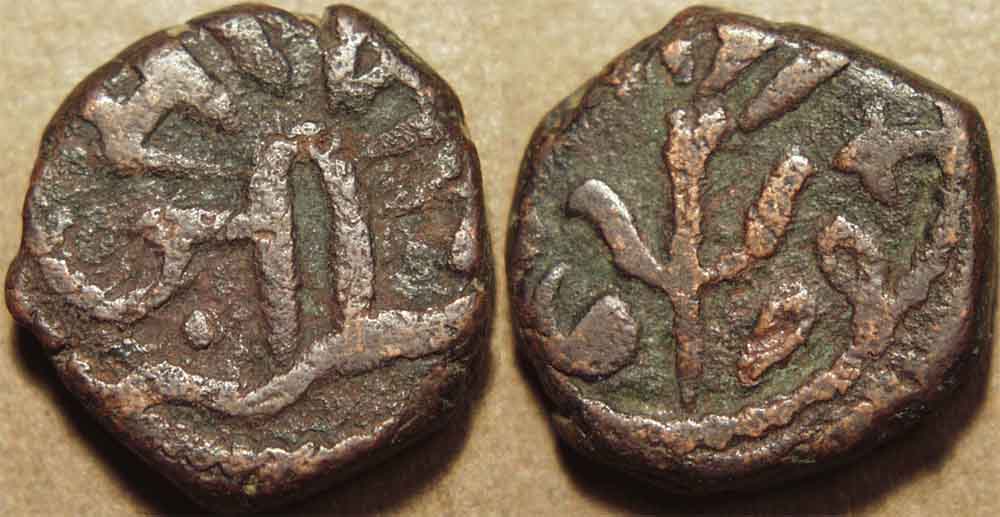
|
Jayaji Rao (1843-1886) AE paisa, VS 1937 (= 1880), Mandasor mint
Weight: 7.47 gm. Diameter: 18 mm Die axis: 3 o'clock
Large Nagari ji with sa ma sa above
Trident, Nagari legend above, VS date 1937 below
Reference: KM 180 (Y2)
|
 |
Madho Rao (1886-1925) |

|
Madho Rao (1886-1925) Copper 1/2 paisa, VS 1957 (= 1900)
Weight: 3.82 gm. Diameter: 20 mm Die axis: 12 o'clock
Saivite symbols, including trident and cobra, Nagari legend around: Sri Madhavrao . ma . Sinde / A . bahadur
(the "ma" probably for maharaj and "a" for Alija)
Legend: Gwalior 1/2 paisa, date below: 1957, all surrounded by a floral scroll within two rows of dots
Reference: KM 164
|
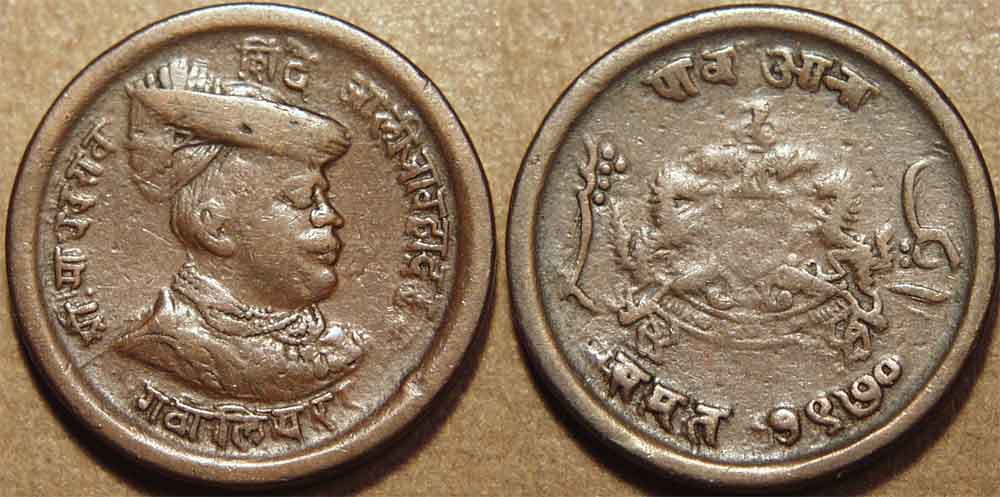
|
Madho Rao (1886-1925) Copper 1/4 anna, thick planchet, VS 1970 (= 1913)
Weight: 6.84 gm. Diameter: 22 mm Die axis: 12 o'clock
Bust of king right, wearing turban, Nagari legend around:
Sri Madhavrao ... Shinde ... Alija bahadur / Gwalior
State coat of arms, Nagari legend above: paav anna, date below: samvat 1970
Reference: KM 170
|
 |
This coin has a thick 2.2 mm planchet.
|

|
Madho Rao (1886-1925) Copper 1/4 anna, thin planchet, VS 1974 (= 1917)
Weight: 5.07 gm. Diameter: 22 mm Die axis: 12 o'clock
Bust of king right, wearing turban, Nagari legend around:
Sri Madhavrao ... Shinde ... Alija bahadur / Gwalior
State coat of arms, Nagari legend above: paav anna, date below: samvat 1974
Reference: KM 171
|
 |
This coin has a thin 1.6 mm planchet.
|
 |
 |
 |
Jivaji Rao (1925-1948) |

|
Jivaji Rao (1925-48) Brass 1/2 anna, VS 1999 (= 1942)
Weight: 2.92 gm. Diameter: 19 mm Die axis: 12 o'clock
Bust of king left, wearing turban, Nagari legend around:
Sri Jivajirao Shinde ... Alija bahadur / Gwalior
State coat of arms, Nagari legend above: adha anna, date below: samvat 1999
Reference: KM 179
|
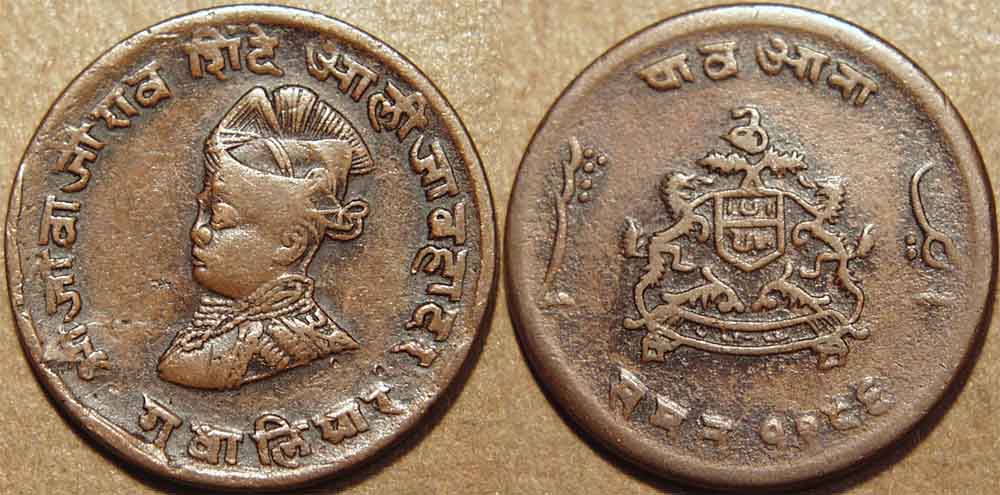
|
Jivaji Rao (1925-48) Copper 1/4 anna, VS 1986 (= 1929)
Weight: 4.89 gm. Diameter: 23 mm Die axis: 1 o'clock
Bust of king left, wearing turban, Nagari legend around:
Sri Jivajirao Shinde Alija bahadur / Gwalior
State coat of arms, Nagari legend above: paav anna, date below: samvat 1986
Reference: KM 177
|
|
|